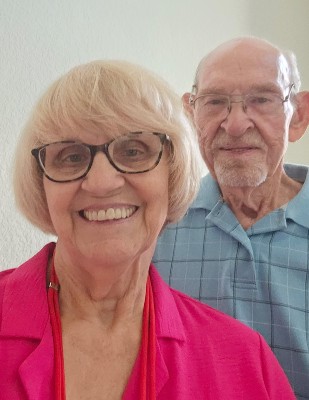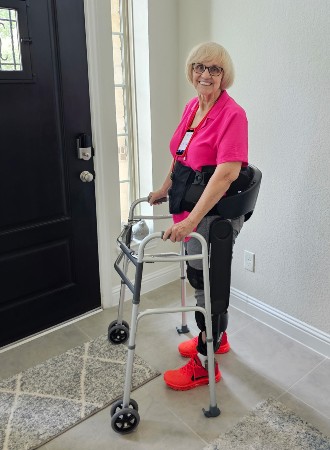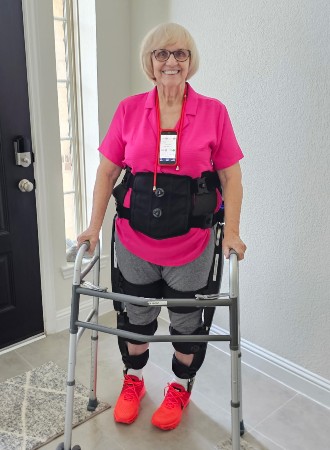 At 76 years old, Shirley Crump carries herself with the warmth and determination of someone who has spent a lifetime refusing to let physical challenges define her. She’s quick to laugh, loves to tell a good story and has a fierce streak of independence — the kind that makes you believe her when she says, “You watch me” in the face of doubt.
At 76 years old, Shirley Crump carries herself with the warmth and determination of someone who has spent a lifetime refusing to let physical challenges define her. She’s quick to laugh, loves to tell a good story and has a fierce streak of independence — the kind that makes you believe her when she says, “You watch me” in the face of doubt.
Shirley had no idea a hidden spinal issue would one day change her life’s course. But what could have been a permanent setback, became the start of a remarkable journey that would lead her to TIRR Memorial Hermann, where advanced rehabilitation and cutting-edge spinal technology would help her regain mobility and reclaim her independence.
The First Signs of Trouble
For most of her childhood and early adulthood, Shirley had no idea anything was wrong with her spine until she was diagnosed with a benign growth in her spine called a hamartoma. “It was a congenital birth defect,” she said. “I didn’t discover it until I was around 25 years old, when I started having problems with the compression it was causing on my spinal cord.”
In 1974, while working a full-time job on her feet, people began to notice changes in her walk, though at first, she didn’t take it seriously. “My friends would tell me I walked funny,” Shirley remembers. “They said I walked like Chester from Gunsmoke with a noticeable limp, but I didn’t feel anything different. I even laughed and said, ‘I’m going to the doctor just to prove there’s nothing wrong with me.’”
But the reality was more serious. She began losing sensation in the lower half of her body, from the waist down, as the tumor slowly compressed her spinal cord.
At the time, Shirley’s husband, Mitchell, was serving in the U.S. Army, so she was referred to Brooke Army Medical Center in San Antonio for evaluation. Over the course of several weeks, doctors conducted physical exams and exploratory testing.
“They wondered if it might be muscular dystrophy or even lingering effects from polio,” she recalled. “But I never had polio, and no one really knew what it was until they found a tumor growing from my L1 to my L5 vertebrae (mid-back to my tailbone),” said Shirley.
Shirley’s neurosurgeon removed as much of the tumor as possible without causing further damage. The compression had already caused paralysis, and she was told she would never walk again without canes or a wheelchair.
Shirley wasn’t ready to accept that. “You watch me,” she recalls telling her doctor.
Walking Again Against All Odds
After more than a month in the hospital, Shirley left walking with a cane and wearing a polio-style leg brace for complete right foot drop. As technology improved in the 1980s, she traded the heavy brace for lighter, molded orthotics that fit inside different shoes, a small but meaningful freedom.
Shirley returned to work full time, taking overseas assignments as a civil servant and later joining the private sector. She spent more than three decades in her career before retiring at around age 60. “For someone who wasn’t supposed to be able to walk, I defied all odds,” she said. “I walked everywhere. But it put a toll on my body.”
Discovering TIRR Memorial Hermann and the Power of Physical Therapy
In 1999, Shirley began working with Teresa Kaldis, MD, her attending physician. “She changed my life,” Shirley said. “I give her all the credit.”
Shirley received ongoing physical therapy to maintain her strength and mobility. Over the years, she used advanced bracing systems, long strand crutches and eventually a scooter for better quality of life at home. She worked with an orthotist, who kept her braces updated, helping her stay as active as possible.
As she entered her seventies, Shirley noticed her balance worsening. Even with braces and crutches, walking was becoming increasingly difficult. That’s when Dr. Kaldis recommended that she explore the groundbreaking and versatile exoskeleton technology available at TIRR Memorial Hermann.
Stepping into the Future: Exoskeleton Therapy at TIRR Memorial Hermann

In September 2024, Shirley came to TIRR Memorial Hermann for an evaluation to determine if an exoskeleton was right for her. The session included her physical therapy team and representatives from the device manufacturer.
The type of exoskeleton Shirley was going to use has several main components: two upper leg struts and two lower leg struts that fit into the user’s shoes, with connectors that secure everything in place. Four powered motors at the hip and knee joints provide assistance for standing and walking. Embedded sensors in the upper leg units detect posture and tilt, and on-board microprocessors use that information to control the device’s movement. In practice, the user initiates certain motions, such as shifting their weight or posture, which triggers the device to step, stop, sit or stand.
“There were three people from the device company and four from TIRR Memorial Hermann, all working together to see if this would be a good fit,” Shirley explained. She was indeed a candidate.
For the next six months, Shirley trained twice a week under the guidance of Kelsey Myers, PT, DPT, a board-certified neurologic clinical specialist at TIRR Memorial Hermann, before she was ready to use the exoskeleton at home. “It’s customized to your body—your gait, step length and joint angles,” Shirley said. “You have to train yourself to move in harmony with it. The device has a variety of settings that can be adjusted by you or your therapist to optimize your gait, and over time, you learn how to respond to those adjustments.”
Over time, Shirley learned how to assemble and disassemble the device, use the walker and crutches designed for it, and even pack it into its rolling suitcase for transport.
At the Forefront of Exoskeleton Research and Rehabilitation
 A leader in exoskeleton research and rehabilitation, TIRR Memorial Hermann incorporates various exoskeleton devices, like the Ekso Indego®, into both therapy sessions and real-world mobility training for patients. FDA-cleared for both clinical and personal use, the Ekso Indego ® is designed for individuals with spinal cord injuries, stroke and other mobility impairments. It supports the legs and lower trunk to enable a natural walking pattern and responds to subtle shifts in body position: leaning forward initiates a step, while standing upright stops movement.
A leader in exoskeleton research and rehabilitation, TIRR Memorial Hermann incorporates various exoskeleton devices, like the Ekso Indego®, into both therapy sessions and real-world mobility training for patients. FDA-cleared for both clinical and personal use, the Ekso Indego ® is designed for individuals with spinal cord injuries, stroke and other mobility impairments. It supports the legs and lower trunk to enable a natural walking pattern and responds to subtle shifts in body position: leaning forward initiates a step, while standing upright stops movement.
The exoskeleton is equipped with two software suites—Motion+ and Therapy+—that make it versatile for rehabilitation. Motion+, which is FDA approved for personal devices, is designed for individuals with more severe or complete injuries. In this mode, the device serves as the primary driver of movement, helping patients take steps with little to no ability to assist. Therapy+ is used with patients who have partial or mild impairments, allowing them to contribute more actively by initiating their own steps. Together, these programs help patients practice gait patterns and weight shifts, supporting rehabilitation and offering individuals with limited mobility the opportunity to walk and regain a sense of independence.
In therapy, the device helps improve strength, endurance and walking mechanics. The personal version, designed for home use, allows patients to integrate walking into everyday life, whether moving around the house, going outside or running errands. Lightweight and portable, it even connects to a mobile app for tracking progress and adjusting settings.
“The device gives people the ability to stand and walk again,” said Kelsey. “By using their own movements to control the exoskeleton, patients remain actively engaged and can apply what they learn in therapy to real-world situations. It is my hope that as accessibility and insurance coverage, like the recent changes with Medicare, continue to expand, more individuals will be able to use these devices to improve their independence and perform aerobic exercise at home.”
By March 2025, Shirley was ready to bring the exoskeleton home. Medicare covered the cost, allowing her to use the device regularly without traveling to a clinic. She affectionately named it “Evelyn” — her middle name — and keeps it in her living room, complete with a pair of bright orange Nike sneakers.
Shirley uses the device at least three times a week or more for 30-minute sessions. “You can tell you’ve had a workout,” she said. “Your pulse is up and your arms and legs are stronger. It’s like being an athlete.”
With the device, she can walk around the house, take laundry to the laundry room and stroll through her neighborhood—all while getting the vital exercise her body needs.
More Than Physical Benefits
For Shirley, the impact is more than physical. “Being able to stand up and look people in the eye is empowering,” she said. “It gives you freedom and that’s what we all want.”
She continues to work with Kelsey and the TIRR Memorial Hermann team for adjustments and guidance, praising them for their support. “They taught me to walk uphill, downhill, on ramps, inside and outside on uneven ground,” she said. “They’re wonderful.”
A Life Without Limits
Shirley’s resilience extends far beyond mobility. Since adapting to life with a spinal cord injury at 25, she has earned an associate degree, a bachelor’s in business, a master’s in life coaching and, in May 2025, a doctoral degree in education. She and her husband of 58 years stay active with their two grown children, four grandchildren and five great-grandchildren as well as spending time at their lake house. Shirley enjoys reading, painting, traveling and cruising.
“I’ve never let this slow me down,” Shirley said. “And I never will. I’m so grateful for the support and guidance from my team at TIRR Memorial Hermann. They’ve helped me keep moving forward every step of the way.”
Learn more about exoskeleton technology at TIRR Memorial Hermann »